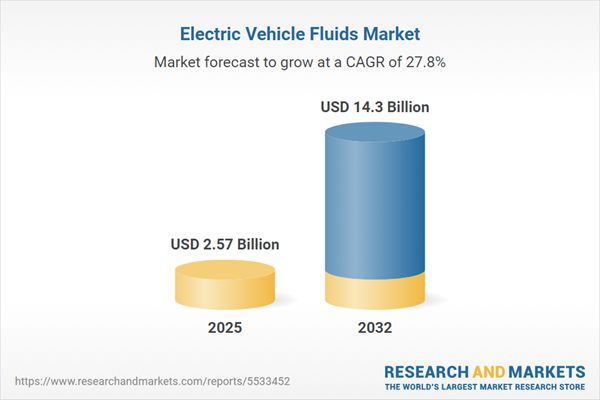Speak directly to the analyst to clarify any post sales queries you may have.
The electric vehicle fluids market is rapidly emerging as a critical enabler of next-generation mobility, underpinning advances in vehicle safety, efficiency, and sustainability for manufacturers and suppliers navigating the automotive energy transition.
Market Snapshot: Electric Vehicle Fluids Market Growth
The Electric Vehicle Fluids Market grew from USD 2.01 billion in 2024 to USD 2.57 billion in 2025. It is expected to continue growing at a CAGR of 27.75%, reaching USD 14.30 billion by 2032.
Scope & Segmentation of Electric Vehicle Fluids Market
- Product Types: Brake Fluids, Coolants, Lubricants (including Gear Oils and Greases), Thermal Management Fluids (such as Battery Cooling Fluids and Dielectric Coolants), Windshield Washer Fluids
- Vehicle Types: Commercial Vehicles, Passenger Vehicles
- Propulsion: Battery Electric Vehicles, Hybrid Electric Vehicles, Plug-in Hybrid Electric Vehicles
- Battery Types: Lithium-ion Batteries, Solid-state Batteries
- End Users: Aftermarket, OEM
- Regions: Americas (North America and Latin America), Europe, Middle East & Africa, Asia-Pacific
- Coverage: Notable company profiles include The Dow Chemical Company, BASF SE, Evonik Industries AG, Solvay S.A., DuPont de Nemours, Inc., Eastman Chemical Company, 3M Company, Honeywell International Inc., Arkema S.A., and Henkel AG & Co. KGaA
Key Takeaways for Senior Decision-Makers
- Accelerating electrification is reshaping fluid requirements, prompting material science innovation and partnerships between OEMs and chemical manufacturers to deliver advanced brake fluids, lubricants, and coolants.
- Thermal management and dielectric coolants are increasingly vital to battery safety, performance, and charge cycle longevity in both established and emerging propulsion and battery architectures.
- Technical collaboration now extends beyond R&D, with real-time data analytics and digital supply chain integration streamlining predictive maintenance and inventory resilience for commercial and passenger electric fleets.
- Diverse regional conditions—such as the extreme climates in Europe, Middle East & Africa or growing gigafactory investments in Asia-Pacific—require fluid solutions tailored for local performance demands and regulatory requirements.
- Companies are expanding from fluid development into adjacent areas like filtration and thermal management hardware, supporting integrated solutions for electric vehicle platforms.
Tariff Impact: Navigating Trade and Cost Pressures in Electric Vehicle Fluids
The 2025 United States tariff schedules have altered cost structures for specialty chemical supply chains, leading to strategic nearshoring, in-house innovation, and revised sourcing strategies for manufacturers and OEMs. These changes have had a ripple effect downstream, prompting distributors and service networks to update their pricing and supply chain models while prioritizing cloud-based visibility and process optimization. Collaboration with local manufacturers and process modernization has become essential to maintain resilience and competitiveness amid evolving trade policies.
Methodology & Data Sources
This analysis employs qualitative and quantitative methods, including primary interviews with senior executives across the electric vehicle fluids ecosystem and extensive secondary research from technical publications and regulatory filings. Data triangulation and scenario planning ensure accuracy and relevance for market participants assessing regional, technological, and regulatory shifts.
Why This Report Matters for Industry Strategy
- Decision-makers gain comprehensive visibility into product-specific and regional trends shaping the adoption of next-generation electric vehicle fluids.
- Stakeholders can benchmark their strategies and investment plans against evolving regulatory landscapes, supply chain dynamics, and technology innovations.
- Actionable insights help manufacturers, suppliers, and service networks align innovation and market entry with key growth corridors and policy directives.
Conclusion
Advanced fluids play a pivotal role in supporting the safe and efficient evolution of electric mobility. Informed strategies built around this market’s trends empower industry leaders to optimize technology portfolios and strengthen competitive positioning amid changing energy and regulatory environments.
Additional Product Information:
- Purchase of this report includes 1 year online access with quarterly updates.
- This report can be updated on request. Please contact our Customer Experience team using the Ask a Question widget on our website.
Table of Contents
3. Executive Summary
4. Market Overview
7. Cumulative Impact of Artificial Intelligence 2025
Companies Mentioned
The companies profiled in this Electric Vehicle Fluids market report include:- The Dow Chemical Company
- BASF SE
- Evonik Industries AG
- Solvay S.A.
- DuPont de Nemours, Inc.
- Eastman Chemical Company
- 3M Company
- Honeywell International Inc.
- Arkema S.A.
- Henkel AG & Co. KGaA
Table Information
| Report Attribute | Details |
|---|---|
| No. of Pages | 187 |
| Published | October 2025 |
| Forecast Period | 2025 - 2032 |
| Estimated Market Value ( USD | $ 2.57 Billion |
| Forecasted Market Value ( USD | $ 14.3 Billion |
| Compound Annual Growth Rate | 27.7% |
| Regions Covered | Global |
| No. of Companies Mentioned | 11 |









